
BB30, a new bottom bracket standard invented by Cannondale in 2000, is gaining momentum. With a bigger 30mm spindle and pressed-in bearings, BB30 is designed to be lighter and stiffer, with an enormous shell that could make the frame stiffer as well. Given the industry’s inexorable movement towards bigger diameter and stiffer components, BB30 could well become the standard in a few years. I took a trip to Mark Purdy’s shop to have a Quarq BB30 Cinqo installed and find out more about the system.
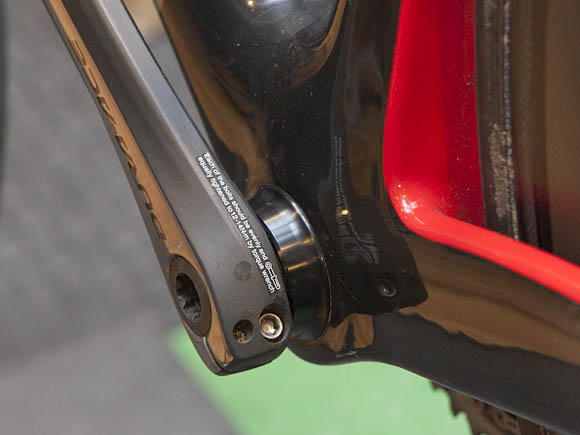
My BH came with these simple and elegant adapter cups to take the BB30 shell down to the Shimano standard. These will have to be knocked out first.
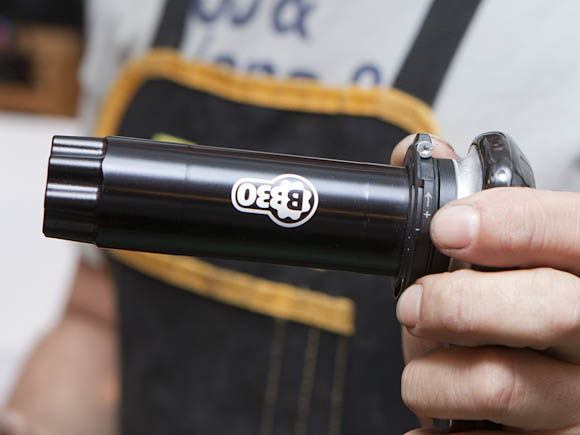
Here’s that big spindle. There’s a ‘preload adjuster’ to take up the slack in the system with a set screw to lock it in. Purdy points out that it’s not technically setting preload, like in a cup and cone system. Cartridge bearings don’t need to be preloaded to keep things in line, in fact, they should have minimal axial load. The adjuster just takes out the slop in the system. Some cranksets use a wave ring instead, both work fine.
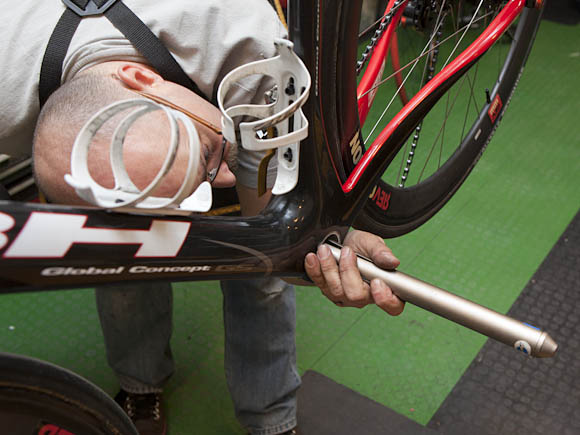
Purdy first knocks the bearings out of the BH adapter cups, then uses a headset removal tool to remove the cups. This is a rare appearance for the headset tool since the advent of internal headsets.

There’s the shell, a smooth bore with two channels. More on those channels later.

Here’s what you get with a bearing kit: 2 outer plates, 2 bearings, and 2 circlips. 60 grams total, or approximately 40 grams less than an outboard BB.

The ever fastidious Purdy cleans the shell with acetone and digs the loctite out of the channels with a dental pick. After he finished with my bike he gave me a root canal.

After greasing, the circlips are snapped into those channels. They serve as a backstop for the bearings.

Since the BB30 shell is completely sealed inside the frame, Purdy recommends taking out the inboard bearing seals to lower friction a touch.

Bearing, less one seal.
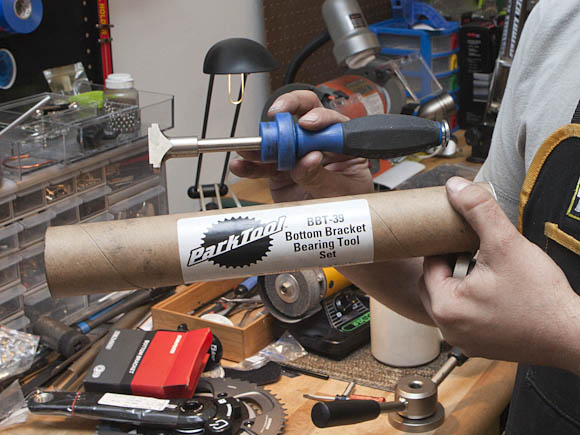
The Park BB30 tool set includes a bearing knockout tool as well as adapters for pressing the bearings.
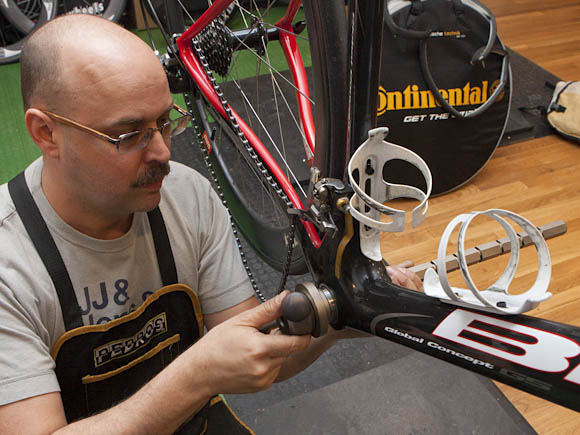
Here’s another tool making a cameo appearance. The Park headset press is used to install the bearings. Purdy adds just a touch of pressure after he feels the bearings bottom out on the circlips.

Bearings in, slightly recessed. The need for specialized tools pretty much preclude the home mechanic from attempting this job.

The non drive side crankarm goes in.

The drive side, with a collar slipped over the spindle. Next to it is a magnet for the Quarq Cinqo.

Drive side bolted on with a giant torque wrench.

Slop taken out with the preload adjuster and set in place with a 2mm allen.
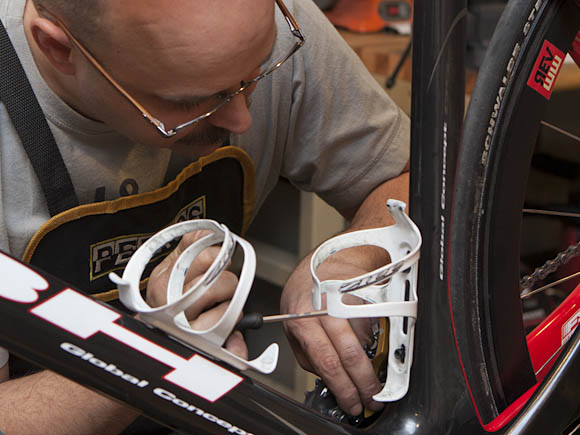
Purdy fine tunes the front shifting.

All done. Despite the weight saved and stiffness gained, Purdy does have a few reservations about the system.
A chain is only as strong as its weakest link, so when you make the crankset stiffer, flex simply migrates to other places. The first Shimano outboard BB cranks made some frames flex so much that it ruined front derailleur shifting. With each step up in crank stiffness frame designers have had to respond in kind and increase frame stiffness as well. While this improves drivetrain efficiency, Purdy wonders if comfort is being sacrificed.
The non drive side crank sits pretty far outboard of the shell, which means the crank takes a fairly straight shot to the pedal axle. This increases the likelihood of heel strikes and wear on the crankarm surface.

Also, the press fit interfaces of BB30 can be a source of creaks. Mechanics differ on whether the interface should have grease, loctite, or nothing at all. Purdy prefers grease, and stresses that careful installation is the key to silent operation.
Finally, there is no tool for milling the shell. If the shell diameter is off, bearings can be compressed when installed. This is bad for steel bearings, but terrible for ceramic bearings, which are less elastic. Purdy looks forward to the introduction of a milling tool so he can confidently recommend ceramic bearings if a customer requests it. UPDATE: The tool is now available, and now Purdy reams out every BB30 frame to ensure proper fit. Make sure your shop has the tool if you’re having your BB30 bike built there.
And the verdict? I really believe in the power of suggestion, so I hate to report ‘sensations’. But the already fantastic BH G5 felt great – smooth, stiff, silent. I was also happy to find that my heel never rubbed the non drive side crankarm, despite the fact that I use Speedplays. If you don’t want to trust my subjective opinions (and you shouldn’t), consider this equally useless piece of evidence. Schmalz exceeded his current max wattage by 50 watts on his G5 with a Sram Force crankset (measured with a Powertap, which is downstream of the crank/BB), and he placed third in field sprint the day he got his bike. So there you go, BB30 is magic.
Have questions about BB30? Post them below and Purdy will respond.

How does MP much charge to replace FSA BB30 bearings including parts and labor?
It is clear that I will not be able to do this myself and I guess it will have to be done at some point and Aaron, if it is the bike I’m thinking of, I think Mark would be able to make a huge difference to your setup.
http://www.enduroforkseals.com/id195.html
also ti-prep can be used on the bearings
just happy to see you?
https://nyvelocity.com/files/u18/IMG_2845.jpg
http://velonews.competitor.com/2010/04/bikes-tech/fsa-components-and-sram-and-zipp-wheels_113384
FSA BB30 reamer
I think Mark needs to go back to the bearded look.
I wass able how to get more instagram followers free
find good information from your articles.
schmalz, giro live feed links?
Cycling fans always consolidates the video, audio and net links.
http://www.cyclingfans.com/node/791
Aaron– I charge $40 for the labor to remove your old setup and install new. The bearings can range from about $60 for good old steel up to $160 or more for Ceramic.
Titouan– That is indeed a good tool kit, but the number of times an individual is likely to use it, it may not be worth it. You can come in to my shop and use a fully equipped workstaion for $20/hour. You have access to every tool in the place and I’m around to answer any questions and make sure nothing goes horribly wrong.
Aurelien– Unfortunately, the FSA tool isn’t available, yet. I am eagerly awaiting it’s arrival, though.
FYI, The full beard is a winter thing. It’s too hot in the summer!
universal sports
“Since the BB30 shell is completely sealed inside the frame, Purdy recommends taking out the inboard bearing seals to lower friction a touch.”
Nice helpful bit of information- shows how little my mechanic knows.
Any one have any feed back to share?
if you pop the inner-facing seals, won’t grease trickle out as the bearings spin?
And you thought it was juice…. he removed all his bearing seals! Now we know.
This guy is simply the best we have.
It is so worth the trip to get it done right the first time every time.
Keep it up Mark.
Please don’t rush home tonight and rip all the seals off every bearing. Although seals do add some drag, they also perform a critical function. Some seals are more necessary than others. If you remove any seal, it will allow the lubricant to go away a bit faster, thus requiring more frequent serviceing. On your race bike you have a choice to make. lower friction or longer life. Just like with tires, you can put on a thick, super durable tire that is heavy and rides like shit… or you can use light, fast race day rubber that punctures more easily. That’s a choice you as the rider get to make. This is another one of those choices. Removing a seal is not the appropriate move for everyone. But if you regularly maintain your bike and want to scrub off any unnecesary friction then go for it. If you have a dedicated TT bike tht you only ride a handful of times each year, then removing all the seals. Seal drag is probably costing you in the neighborhood of 20 watts on your hubs, Der. pulleys and BB bearings. But you have to pull the bike apart, clean it and re-lube everything after each ride
If I remove seals on my race hubs. What
type of grease to relube?
If you do remove the seals, use a medium to lightweight oil.
sounds too good to be true
I prefer to use Pam olive oil spray.
I use Purdy palm oil.
… But Pam is commonly used for such applications. (she’s such a slut!)
20 watts is not a guarentee or promise of any kind. But it is a very realistic guess.
https://nyvelocity.com/files/u18/IMG_2869.jpg
Did you learn that tool-handling style here?
http://www.youtube.com/watch?v=tdbt-sx5MDc&feature=related
Hey Dan…
chk this link out.
Its much better than cyclingfans because it has video excerpts as well as live feed and text links all consolidated along with photo’s + it allows you to select the race you’d like to follow – any professional and continental pro race. It’s almost better than cyclingtv because, well one doesnt have to pay for it and its jam packed full of events!
http://www.steephill.tv/
enjoy!
So some people are using BB30 adapters to continue to use regular BB shells. Are these more prone to creek like mad? or creek more than non-BB30 adapter setup? I’m eye balling a frame with BB30 but am on the fence on continuing to use a pre-existing BB and cranks instead of buying a whole new crankset.
Then to the author (Andy), you say its possibly lighter but don’t provide any data. Did you weigh pre and post BB30 setup? To prove, disprove it on your setup? Just nit picking and just want a known listing if it is lighter or not, I know its probably only 10 grams or so but still good to see.
BB30 bearings 40 grams lighter than outboard BB, BB30 Cinqo about 60 grams lighter than Sram Cinqo.
common sense says that the more contact surfaces (bb shell to sleeve, sleeve to bb) the more likely there is to be noise.
I sincerely doubt all the seals on your bike account for 20 watts of drag. Maybe 5. If it was anything significant or testable, we’d have FSA et all sell us on their brand new dragless seal system that turns us all into Alberto Contador.
Of course, the amount of drag you eliminate by removing seals depends on how much drag you had to begin with. Some seals are more effective than others, while other seals privide less drag, but less of a seal. Since niether one of us is actually going to do a test to prove or disprove. I’ll re-state my earlier quote (in case you missed it) “Seal drag is probably costing you in the neighborhood of 20 watts on your hubs, Der. pulleys and BB bearings.” Note the clever useage of the terms “probably” and “neighborhood”. 20 watts may be a high estimate, but 5 watts is a pretty low estimate. You’ll save that on the BB alone.
When using an adapter to “downsize” to a traditional shell… Since the adapter is press-fit and uses loctite, the chance of creaking is pretty low. I haven’t noticed it on any of the adapters I’ve seen in use.
Watts up, doc?
Some numbers for comparison…
SRAM Force Crank w/ GXP BB = 791 grams
SRAM Force Crank w/ BB30 = 645 grams
SRAM Red Crank w/ GXP BB = 760 grams
SRAM Red Crank w/ BB30 = 630 grams
Seems like major weight savings with SRAM.
FSA cranks seem to save about 80 grams overall.
BB30 can yield a lighter crankset just like oversized tubes get you a lighter aluminum bike. BB30 lets the manufacturer change from a steel BB spindle to an aluminum one. So there are weight savings to be had because of this change in material and design.
I enjoy what you guys are up too. This sort of clever work and reporting!
Keep up the superb works guys I’ve added you guys to my own blogroll.
my web site – site – Agustin –
Is this Purdy guy going for a Wright Bros look or is that mustache leftover from his Halloween costumer as “creepy neighbor”?
That 3rd picture is interesting.
I don’t have significant amounts of $$$ to switch over to BB30, all my bikes are standard BB and therefore all my cranks either SRAM GXP or Shimano compatible.
However I just got a great deal on a Jamis Xenith SL, which is a BB30 frame. I often interchange my SRAM and Shimano cranks depending on type of race. Why is this you ask… different length cranks, SRAM is 175 and Shimano 172.5 but that a different discussion.
My question… is there an adapter that can convert the BB30 shell so that I can use both SRAM and Shimano. Without having to change anything but the cranks. My understanding is that the adapters either work for SRAM or Shimano not both.
I’ll ask Purdy to comment, but my guess is you can use one of those press-in sleeves and then screw in a sram or a shimano BB?
http://www.universalcycles.com/shopping/product_details.php?id=29424
that will be greatly appreciated.
If you can get some clarification as to if the FSA BB30 Bottom Bracket Adapter will it work for both SRAM GXP and Shimano compatible cranks.
Although the FSA BB30 Bottom Bracket Adapter will permanently change the BB30 shell to standard, there is no going back once installed I was told, but I don’t mind that.
Hello Mr. Hole,
OK, first… There are two ways to accomplish converting a BB30 frame for use with Std (24mm) cranks.
Option A: is to install a sleeve which downsizes the BB shell to the traditional, threaded style. Like the FSA you mention or others manufacturers make similar items. This is considered a “permanent” conversion. however… It’s not Permenent, permanent. You won’t install, remove, re-install, re-remove, re-re-install… you get the point. Once it’s in, it’s in. You CAN remove it in the future. But you don’t want to do this operation more than one time. Doing so runs the risk of damaging the original BB30 shell and you may never be able to use it as a BB30 the way the manufacturer intended. Basically, if you install the insert now, you can (carefully) remove it later. But you only get to do that one time.
Option B: install BB30 bearings into the frame and use these:
http://wheelsmfg.com/content/view/891/67/
They are shims that downsize the 30mm hole in the bearings to the 24mm axle. Unfortunately, Sram and Shimano have slightly different philosophies about the details so you must use a unique shim set for each style of crank. This shouldn’t be a problem for you since you have had to change the bb each time you change the crankset anyway.
All things considered, I think that Option B is an easier and less expensive switchover. At my shop I sell those shims for $32 per set. Of course, you will need the BB30 bearing assembly also, but that might come with the frameset. If not, they can be had for around $60 for steel bearings or $160+ for Ceramic.
Hope this helps,
Sensei
I may have glossed over one compatibility issue. Sram Cranks and BB’s and Shmano Cranks and BB’s are NOT compatible with each other in any way. If you use a Sram Crank, you must use a Sram BB. A Shimano BB will not now or ever work with it. And vice versa.
Unless….. Shimano get’s with the program and starts making BB30 cranksets. Then the cranks will be interchageable with any BB30 frame.
but as of now and the issue of the 24mm standard, no cross compatibility between those two companies.
Sensei
I don’t mind installing FSA sleeve into frame, I don’t see my self switching to BB30 anytime soon, so permanency isn’t an issue.
But once I install the FSA sleeve, would I be able to use either SRAM or Shimano BB and cranks? The reason for my confusion is that someone was telling me that the FSA adapter only works for Shimano and if I needed to use SRAM I would need the following instead of the FSA adapter.
http://www.competitivecyclist.com/za/CCY?PAGE=BUY_PRODUCT_STANDARD&PRODUCT.ID=6256&CATEGORY.ID=19&MODE=&TFC=TRUE&TOP_PARENT.ID=&BRAND.ID=
Basically they told me the GXP BB wont work with FSA adapter. But Shimano does. I am not to great with technical bicycle stuff, so excuse my ignorance.
… On whoever (or is it whomever) told you that the FSA doesn’t work with Sram. The two adapters are the same thing. The only difference is the color. There is no functional difference between the two.
However, it is possible that there is simple confusion about what “Adapter” he/she was referring to. The permanent press in sleeve is the same all the way around. But the Wheels Mfg. adapter shims that I mentioned earlier are different between Sram and Shimano. Shimano and FSA use the same Shim adapter. Maybe that’s what they were talking about.
Sensei
very nice, well that settles it. FSA adapter it is! As a Jamaican team mate would say… big up star!!! Thanks
å…¬å¸å®£ä¼ çš„é‡è¦é€”径
一部ç–åˆ’ä¼˜è‰¯çš„å®£ä¼ ç‰‡ï¼ˆåˆç§°å…¬å¸å½¢è±¡å®£ä¼ 片)å¯åœ¨å‡ 分钟内å‘ç›®æ ‡è§‚ä¼—ä¼ é€’å‡ ä¸‡æ–‡å—å’Œå‡ ç™¾å¼ å›¾ç‰‡æ‰€èƒ½è¡¨çŽ°çš„ä¼ä¸šä¿¡æ¯é‡ï¼ŒåŽŸå› 很简å•ï¼šå› 为人们从外界å¸æ”¶çš„ä¿¡æ¯æœ‰ç™¾åˆ†ä¹‹ä¹å以上是通过视觉的,尤其是影åƒçš„ä¿¡æ¯å¯†åº¦æœ€å¤§ã€‚æ›´é‡è¦çš„是能为ä¼ä¸šå’Œå®¢æˆ·éƒ½èŠ‚约许多å®è´µæ—¶é—´ã€‚
有创æ„ã€è‰ºæœ¯åŒ–çš„ä¼ä¸šå½¢è±¡ç‰‡èƒ½åœ¨è§‚众心ä¸ç•™ä¸‹æ·±åˆ»çš„å°è±¡ï¼Œæ›´å¥½åœ°ä¼ æ’商业信æ¯ã€‚ä¼ä¸šå½¢è±¡ç‰‡ä½œä¸ºä¼ æ’商业信æ¯çš„一ç§æ‰‹æ®µï¼Œä¼ æ’ä¸çš„美感å分é‡è¦,å› ä¸ºç¾Žçš„ä¸œè¥¿èƒ½å¸å¼•è§‚众的目光,艺术化的产å“æ‰ç¬¦åˆçŽ°ä»£äººå¯¹ç¾Žçš„追求ã€å¸å¼•äººçš„注æ„力,è¿™æ˜¯å®žçŽ°ä¼ æ’效果的第一æ¥ã€‚现代广告艺术是将艺术性建立在商业性实用目的之上,这对ä¼ä¸šå½¢è±¡ç‰‡ä¹ŸåŒæ ·é€‚用。è¦è¾¾åˆ°ä¼ä¸šçš„最终商业目的——æ ‘ç«‹ä¼ä¸šå½¢è±¡ã€ä¿ƒè¿›äº§å“销售,必须用艺术性包装ä¼ä¸šå½¢è±¡ç‰‡,ä¼ä¸šå®£ä¼ 片制作,使其具有足够的å¸å¼•åŠ›,让观众在艺术享å—的愉悦ä¸å¼•èµ·å¯¹ä¿¡æ¯çš„关注,建立对ä¼ä¸šå“牌的认知,æœ€ç»ˆè¾¾åˆ°æœ€ä½³çš„ä¼ æ’效果。
ä¼ä¸šå½¢è±¡å®£ä¼ 片作为公å¸å®£ä¼ åŠè¥é”€çš„é‡è¦å·¥å…·ï¼Œåªè¦ä¼ä¸šé¢†å¯¼å¯¹å®ƒçš„认知和é‡è§†ç¨‹åº¦é«˜ï¼Œç»è´¹çš„投入足ã€åˆ¶ä½œçš„把关严ã€æ¸ é“çš„ä¼ æ’广;åªè¦åœ¨åˆ¶ä½œå’Œè¿ç”¨ä¼ä¸šå½¢è±¡å®£ä¼ 片过程ä¸çŽ¯çŽ¯ç›¸æ‰£ã€æ¥æ¥ä¸ºè¥ã€å…¨ç›˜æŠŠæŽ§ï¼Œå°±èƒ½è®©å®ƒçš„è¥é”€é”‹èŠ’毕现,为ä¼ä¸šå“ç‰Œçš„æ‰“é€ å’Œäº§å“的销售建功立业。
ä¼ä¸šå®£ä¼ 片的æ„义
 ,ä¼ä¸šå®£ä¼ 片制作;
在市场ç»æµŽæ—¶ä»£ï¼Œæ—©å·²ç»è¿‡äº†“酒香ä¸æ€•å··åæ·±”的年代了ï¼ä¼ä¸šè¥é”€ï¼Œå¸‚场è¥é”€ï¼Œå¹¿å‘Šå®£ä¼ å·²ç»é布我们生活的æ¯ä¸€ä¸ªè§’è½ï¼Œä¼ä¸šå®£ä¼ 片也是一个è¥é”€æ‰‹æ®µã€‚
ä¼ä¸šçš„长期利润æ¥è‡ªäºŽå“ç‰Œé™„åŠ å€¼çš„æå‡ï¼Œå¦‚何æå‡ä¼ä¸šçš„形象ã€å¢žåŠ å“ç‰Œçš„é™„åŠ å€¼ï¼Œå®£ä¼ çš„å½¢å¼è‡³å…³é‡è¦ã€‚ ä¼ä¸šå®£ä¼ ä¸ä»…仅是æ‹æ‘„制作一套光盘那么简å•ã€‚ä¼ä¸šåˆ¶ä½œå®£ä¼ ç‰‡çš„æœ€ç»ˆç›®çš„æ˜¯ä¼ æ’ä¼ä¸šå½¢è±¡ï¼Œé”€å”®äº§å“。它è¦æ±‚çš„ä¸ä»…仅是画é¢çš„精美ã€å†…容的生动,更è¦æ±‚能够统一ä¼ä¸šå½¢è±¡å’Œäº§å“特点。这ç§å¤šåª’ä½“å®£ä¼ ç‰‡ç‰¹ç‚¹æ˜¯æŠ•å…¥å°ï¼Œå—众针对性强ã€æ’放地点çµæ´»ç‰ã€‚
ä¼ä¸šåšå®£ä¼ 片首先è¦æ˜Žç¡®ç›®çš„。为什么è¦åšå®£ä¼ 片?ä¼ä¸šåˆ¶ä½œå®£ä¼ 片是为了æå‡ä¼ä¸šå½¢è±¡è¿˜æ˜¯ä»‹ç»äº§å“?如果是为了æå‡ä¼ä¸šå½¢è±¡é‚£å½“然是åšä¼ä¸šå½¢è±¡ç‰‡ã€‚很多ä¼ä¸šï¼Œç‰¹åˆ«æ˜¯ä¸å°ä¼ä¸šè‡ªèº«çš„形象并ä¸æ˜¯å¾ˆçªå‡ºï¼Œåœ¨ä¼ä¸šå†…éƒ¨å¯¹è‡ªèº«æ²¡æœ‰ä¸€ä¸ªç»Ÿä¸€çš„è®¤è¯†ï¼Œåœ¨æ¸ é“和消费者ä¸ä¹Ÿæ²¡æœ‰å½¢æˆå½±å“和共识,这对ä¼ä¸šçš„å‘展是å分ä¸åˆ©çš„。那么ä¼ä¸šå°±éœ€è¦å°†è‡ªèº«çš„资æºè¿›è¡Œæ•´åˆï¼Œæ炼出一个统一的ä¼ä¸šå½¢è±¡ã€‚如果ä¼ä¸šè¦åšçš„是产å“直销片,和ä¼ä¸šå½¢è±¡ä¸€æ ·ï¼Œäº§å“的特点和功能定ä½ä¹Ÿå¾ˆé‡è¦ã€‚产å“有产å“的形象,产å“的功能定ä½åº”该能够体现出由产å“所展示的å“è´¨ã€å“味和å“形到å“ç‰Œçš„è¿‡æ¸¡ã€‚äºŽæ˜¯ï¼Œå®£ä¼ ç‰‡çš„æ„义就在于å¯ä»¥å¸®åŠ©ä¼ä¸šå®žçŽ°ä¼ä¸š——代ç†å•†ã€ç»é”€å•†——零售商——消费者对ä¼ä¸šå½¢è±¡å’Œäº§å“达到共识。
Write very well, you will be an excellent editor, and I hope in the future to reach more of your articles!longchamp sale
Not all articles are written so well, your writing is really good!
Not all articles are written so well, your writing is really good!uggs outlet clearance